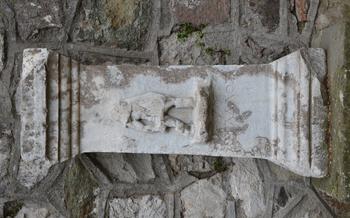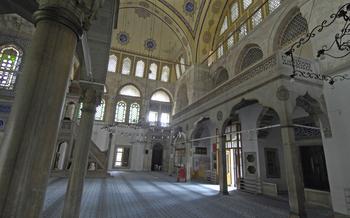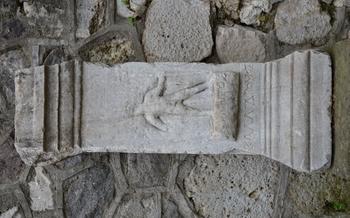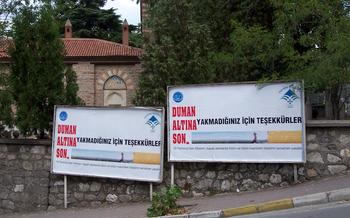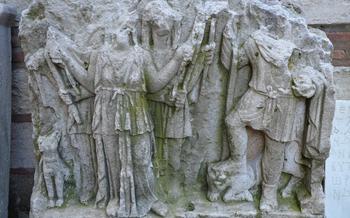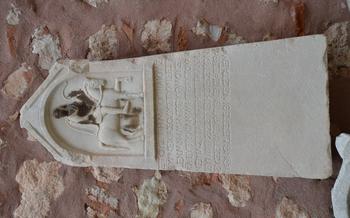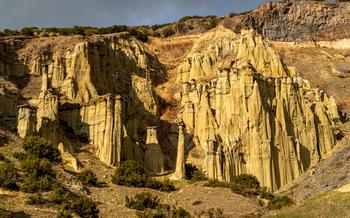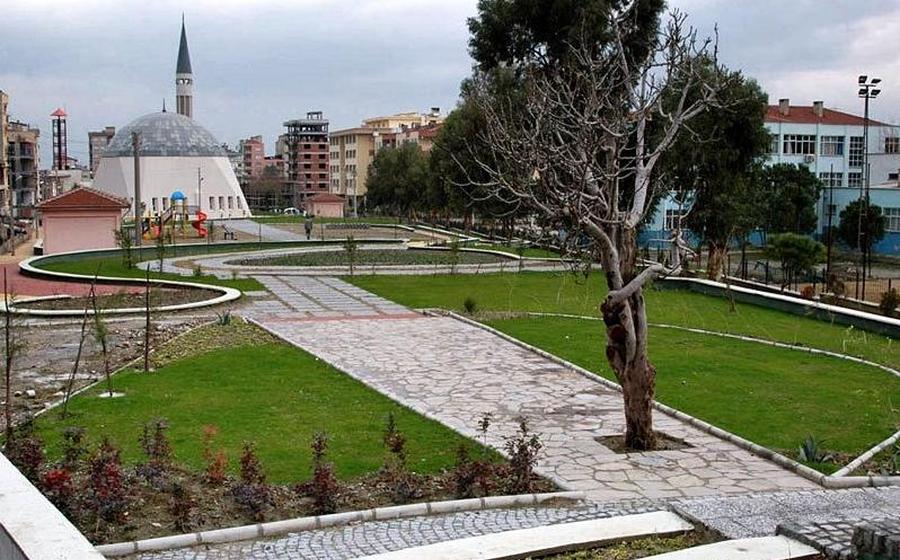
Kula Peribacalari Geopark
- Geological formations and their significance
- Getting There:
- Exploring the Fairy Chimneys
- Visiting the Kula Ethnographic Museum
- Shopping for Local Handicrafts
- Trying Local Cuisine
- Visiting Kula Fortress
- Hiking in Spil Mountain National Park
- Attending Local Festivals
- Visiting the Kula Olive Oil Museum:
- Exploring the Surrounding Villages
- Photography Tips: Capturing the Magic of Kula
- Insider Tip:
Geological formations and their significance
The Kula Peribacalari Geopark is a unique geological wonder located in the town of Kula, in the Manisa province of Turkey. The geopark is home to a stunning array of fairy chimneys, which are tall, cone-shaped rock formations formed by the erosion of volcanic ash and tuff. These fairy chimneys are a testament to the region's rich geological history and are a popular destination for tourists from all over the world.
The Kula Peribacalari Geopark is also home to a variety of other geological formations, including lava domes, ash flows, and pyroclastic deposits. These formations provide a glimpse into the volcanic activity that shaped this region millions of years ago. The geopark is also home to a number of fossils, including those of ancient plants and animals. These fossils provide valuable insights into the region's paleontological history.
The Kula Peribacalari Geopark is a significant geological site and is recognized by UNESCO as a World Heritage Site. The geopark is also a popular destination for scientific research and education.
Getting There:
Reaching Kula is a breeze, with multiple transportation options available. From major cities like Istanbul or Ankara, hop on a comfortable bus or train and enjoy the scenic journey. The ride takes about 10 hours, providing ample time to relax and soak in the changing landscapes. If you're driving from nearby towns like İzmir or Bursa, the drive is shorter, taking around 3-4 hours.
For a more personalized experience, consider renting a car and embarking on a road trip. The routes leading to Kula offer breathtaking views, with picturesque villages and rolling hills dotting the countryside. Along the way, stop at local markets or historical sites to delve deeper into the region's charm.
Whether you choose public transportation or self-drive, hiring a local guide can enhance your trip. These guides not only provide insights into the region's history and culture but also lead you to hidden gems and lesser-known spots that might otherwise go unnoticed. Embrace the local hospitality and let them unveil the secrets of Kula.
Exploring the Fairy Chimneys
The fairy chimneys of Kula Peribacalari Geopark are otherworldly formations that have captivated visitors for centuries. These towering rock structures, shaped by centuries of erosion, resemble giant mushrooms or spires, creating a surreal landscape that is unique to this region.
Hiking trails of varying difficulty levels wind through the geopark, allowing visitors to explore the fairy chimneys up close. The most popular trail is the easy-to-moderate Kula Kaya Ormanlari Trail, which takes you past some of the most impressive formations, including the iconic Mushroom Rock.
For those seeking a more challenging hike, the Kula Zirvesi Trail offers a strenuous but rewarding climb to the summit of Kula Zirvesi, the highest point in the geopark. The breathtaking views from the top are worth the effort, as you can see the fairy chimneys spread out before you like a vast army of stone giants.
Remember to bring your camera to capture the stunning beauty of the fairy chimneys. The best time to visit is early morning or late afternoon, when the soft, golden light casts a magical glow on the landscape. Be sure to respect the natural formations and avoid climbing or damaging them, as they are irreplaceable treasures of geological heritage.
Visiting the Kula Ethnographic Museum
The Kula Ethnographic Museum offers a fascinating journey into the rich cultural heritage of the Kula region. Established in a restored historical building, the museum houses an array of exhibits that showcase the traditional lifestyle, customs, and craftsmanship of the local people.
Among the highlights of the museum are displays of traditional clothing, intricate embroidery, and handcrafted jewelry, providing a glimpse into the artistry and skills of the region's artisans. Visitors can learn about the daily life and occupations of the local population, including agriculture, animal husbandry, and weaving.
The museum also features a collection of household items, tools, and utensils, offering insights into the domestic life of the Kula people. Guided tours are available, providing visitors with a deeper understanding of the cultural and historical significance of the exhibits.
Educational programs are organized for visitors, particularly for students and researchers, to promote cultural awareness and appreciation. The Kula Ethnographic Museum serves as a valuable resource for preserving and promoting the unique cultural identity of the region.
Shopping for Local Handicrafts
Kula is renowned for its vibrant handicrafts scene, offering a treasure trove of traditional Turkish souvenirs and unique pieces. Stroll through the bustling markets or visit local artisans' workshops to discover an array of carpets, pottery, jewelry, and handmade textiles. Each item is lovingly crafted, showcasing the skill and artistry of local artisans.
By purchasing these handicrafts, you not only take home a piece of Kula's cultural heritage but also support the livelihood of local artisans and help preserve traditional practices. Engage in friendly bargaining to find the best deals and don't hesitate to ask about the stories behind each creation.
Look out for intricate carpets adorned with vibrant motifs, meticulously painted pottery with unique designs, and shimmering jewelry handcrafted with local stones. These items make for cherished souvenirs or thoughtful gifts for loved ones back home.
Trying Local Cuisine
Kula offers a tantalizing array of culinary delights that reflect the region's rich cultural heritage. Manisa kebabs, succulent skewers of marinated lamb or chicken grilled to perfection, are a must-try. Kula pide, a traditional flatbread topped with savory fillings like cheese, meat, or vegetables, is another local favorite. For a hearty and comforting meal, indulge in ** keşkek**, a slow-cooked stew made from wheat, meat, and chickpeas.
Vegetarians and vegans will find plenty of options to satisfy their taste buds. Zeytinyağlı yemekler, a diverse range of vegetable dishes cooked in olive oil, are a staple of Turkish cuisine. Meze platters, featuring an assortment of small dishes like hummus, baba ghanoush, and stuffed grape leaves, are perfect for sharing and sampling local flavors.
To accompany your meal, sip on a glass of şalgam suyu, a refreshing fermented turnip juice that is unique to the region. For a sweet treat, don't miss the cezerye, a delectable carrot-based dessert that is a local specialty.
Whether you're dining at a traditional Turkish restaurant or savoring homemade dishes at a local guesthouse, be sure to embrace the opportunity to experience the culinary wonders of Kula.
Visiting Kula Fortress
Kula Fortress, a majestic symbol of Kula's rich history, stands tall overlooking the town and the surrounding countryside. Constructed in the 14th century by the Aydınoğulları Beylik, this formidable fortress served as a strategic military stronghold, protecting the region from invaders. Its impressive walls, towers, and gates have withstood the test of time, showcasing remarkable architectural features that blend Byzantine and Ottoman influences.
Ascending to the ramparts of the fortress rewards visitors with breathtaking panoramic views of Kula and its environs. The picturesque landscape, dotted with fairy chimneys, vineyards, and olive groves, stretches out before you, creating a picture-perfect vista. Explore the fortress grounds, marveling at the intricate stonework, arched doorways, and remnants of past civilizations. Discover hidden chambers and secret passages that whisper tales of battles, sieges, and the passage of time.
To reach Kula Fortress, follow the signs from the town center. The fortress is accessible by car or on foot, offering a pleasant uphill walk through narrow cobblestone streets. Once at the entrance, you'll be greeted by a stunning gate adorned with intricate carvings. Inside, explore the various sections of the fortress, including the barracks, the water cistern, and the mosque. Capture the essence of Kula's history through photographs and memories that will last a lifetime.
Hiking in Spil Mountain National Park
Just a short drive from Kula, Spil Mountain National Park offers a diverse range of landscapes and ecosystems waiting to be explored. Lace-up your hiking boots and embark on one of the many trails that wind through the park, catering to various fitness levels. As you traverse the rugged terrain, marvel at the unique rock formations, lush forests, and cascading waterfalls that make this park a true natural wonder. Keep your eyes peeled for native flora and fauna, including rare species that call this ecosystem home. Remember to pack all the essentials, including water, snacks, and a camera to capture the breathtaking views. Above all, embrace the opportunity to connect with nature and immerse yourself in the tranquil beauty of Spil Mountain National Park.
Attending Local Festivals
Kula comes alive during its annual festivals, which showcase the vibrant culture and traditions of the region. The most notable event is the Kula Peribacalari Festival, held every year in June. The festival features traditional music, dance performances, culinary experiences, and local handicrafts. Visitors can witness the unique "fairy chimney weddings", where couples exchange vows amidst the enchanting rock formations. Other festivals throughout the year celebrate local agriculture, such as the Kula Olive Oil Festival and the Kula Grape Festival. These events offer a fantastic opportunity to meet locals, immerse oneself in Turkish culture, and indulge in delicious regional cuisine. To make the most of your trip, research upcoming events and plan your visit accordingly.
Visiting the Kula Olive Oil Museum:
Kula has a thriving olive oil industry, and its museum offers an immersive journey into the world of olive cultivation and oil production. The museum showcases traditional and modern olive oil production methods, artifacts, and machinery used throughout history. Visitors can learn about the importance of olive trees in Turkish culture and the role they play in the local economy.
The museum also features displays on the different olive varieties grown in the region, highlighting their unique characteristics and flavors. Interactive exhibits allow visitors to experience the process of extracting oil from olives and taste different varieties. Visitors can also purchase a variety of olive oil products, including soaps, cosmetics, and culinary oils, supporting local producers and savoring the flavors of Kula's olive harvest.
Exploring the Surrounding Villages
Beyond the enchanting fairy chimneys, the Kula region is a tapestry of charming villages nestled amidst rolling hills and verdant valleys. Each village holds its unique character and allure, inviting visitors to delve into the heart of rural Turkey.
Ahmetli: Known for its well-preserved Ottoman architecture, Ahmetli boasts historic mosques, traditional houses, and a vibrant weekly market.
Gölmarmara: Situated on the shores of Lake Marmara, this picturesque village offers stunning views, water sports activities, and delectable fish restaurants.
Salihli: A bustling town with a rich history, Salihli is home to ancient ruins, a lively bazaar, and thermal springs renowned for their healing properties.
Sarıgöl: Surrounded by lush forests and sparkling lakes, Sarıgöl is a nature lover's paradise, with opportunities for hiking, camping, and birdwatching.
Soma: Once a coal mining town, Soma has transformed into a cultural hub, with art galleries, museums, and an annual theater festival.
Venturing into these villages allows travelers to connect with the locals, experience traditional Turkish hospitality, and discover hidden gems off the beaten path. Whether it's a day trip or an overnight stay, exploring the surrounding villages offers a glimpse into the authentic soul of the Kula region.
Photography Tips: Capturing the Magic of Kula
Documenting the Enchanting Landscapes:
Whether you're a seasoned photographer or just starting out, Kula Peribacalari Geopark offers a wealth of opportunities to capture stunning images. With its unique geological formations, picturesque landscapes, and vibrant cultural heritage, the geopark is a photographer's paradise.
Recommended Camera Settings and Techniques:
To make the most of your photography adventure, consider using a wide-angle lens to capture the grandeur of the fairy chimneys and the vastness of the landscapes. Experiment with different shutter speeds to convey a sense of movement or freeze the action of wildlife. For vibrant colors and crisp details, shoot during the golden hours of sunrise and sunset.
Panoramic Shots and Natural Light:
To create breathtaking panoramic shots, use a tripod to ensure stability and stitch multiple images together in post-processing. Take advantage of the natural light to enhance the colors and textures of the fairy chimneys. Soft morning light or warm evening glow can add a magical touch to your photographs.
Sharing Responsibly and Respecting the Geopark:
As you share your beautiful captures online, remember to tag the location and use relevant hashtags to inspire others to visit Kula. However, always respect the geopark's natural formations and cultural heritage. Avoid disturbing the wildlife and refrain from climbing or damaging the fairy chimneys.
Insider Tip:
Discover the hidden gem of Kula Peribacalari Geopark by venturing off the beaten path. For a breathtaking panorama, climb to the top of Deveci Hill, where you'll be rewarded with mesmerizing views of the fairy chimneys and the surrounding countryside. Embrace the local culture by visiting the weekly market in Kula town, where you can haggle for traditional handicrafts, savor delicious street food, and interact with friendly locals. Remember to respect the natural beauty and cultural heritage of the geopark by avoiding littering, staying on designated trails, and asking permission before taking photos of people. Immerse yourself in the authentic Turkish experience by learning a few basic phrases, such as "Merhaba" (hello) and "Tesekkur ederim" (thank you). Your genuine efforts to engage with the locals will be warmly welcomed and enhance your overall experience.
